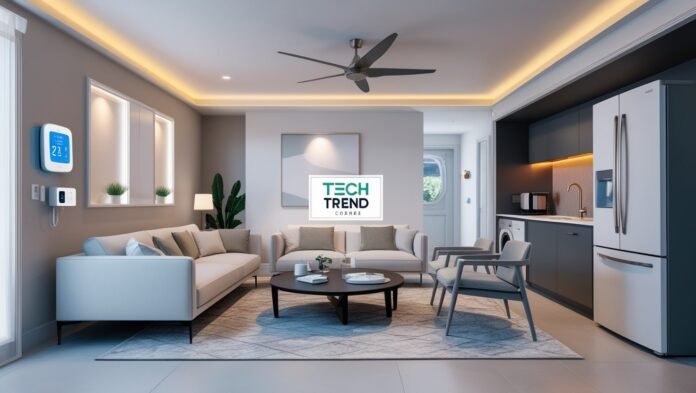Come year 2025, futuristic home technologies will have advanced so much that people will have so many options to make their homes smarter in energy efficiency. Adopting Energy-Efficient Smart Home Devices 2025 is indeed economical because it saves energy consumption in the first place; therefore, people use them for savings on utility bills. The entire guide provides information about the most adequate devices that can transform your home into an energy-efficient haven, all made possible while ensuring comfort, sustainability, and cost efficiency.
Criteria that Help in Choosing Smart Home Devices for Energy Efficiency
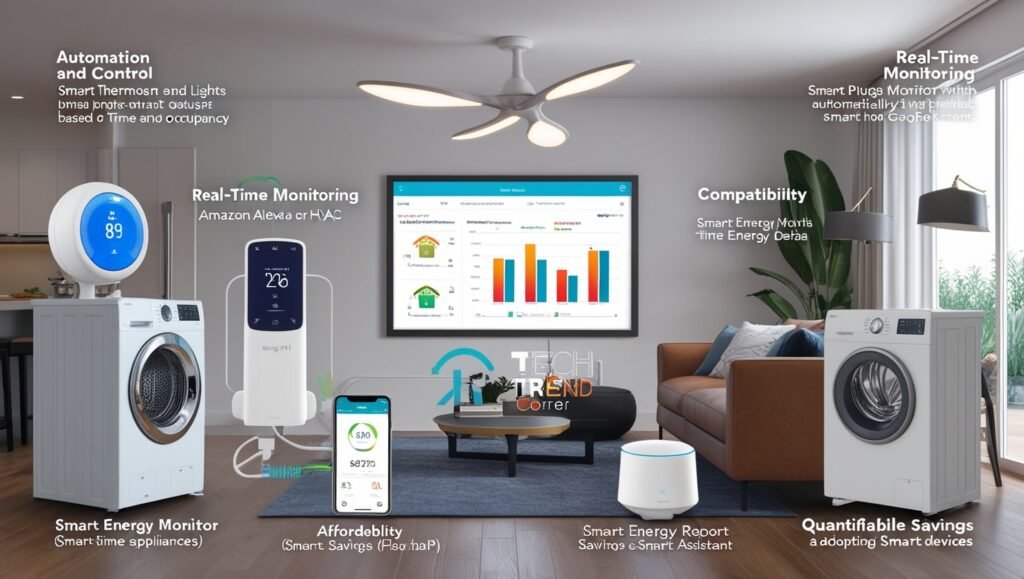
Selecting the required Energy-Efficient Smart Home Devices 2025 requires a careful consideration of several factors so as to get the maximum energy efficiency, they should fit well into the home without a bumpy transition. Here are the main criteria:
- Automation and Control: Look for devices that can be programmed to schedule the activity depending on daily routines. Having remote control through mobile applications or through voice assistants provides a good opportunity for flexibility and convenience.
- Compatibility: It is also important that the devices can work well with the already existing eco-system smart home. Thus compatibility with Amazon Alexa platform, Google Assistant, Apple HomeKit, etc. makes device management easy.
- Real-Time Monitoring: Real-time power usage data enable choosing of energy-related decisions to be split. Can tell which appliance uses the most energy and can inform on which areas can be improved.
- Affordability: The device interfaces and installation procedures must be very accessible, such that an installation of the applicable device could be a walk in the park; even with minimal technical competence, the installation should be simple and straightforward.
- Flexibility: Can these devices be scalable along with your current application needs for a smart home? Definitely, a scalable system should keep your entire house energy-efficient while adding new smart devices to your home over time without complete modification.
Energy-Efficient Smart Home Devices 2025 that will obviously save your energy in lighting and everyday chores should be tailored to fit the lifestyle; thus, take into account these criteria at the selection process.
Top Smart Home Devices for Energy Efficiency in 2025
By 2025, smart home devices will revolutionize energy efficiency, offering homeowners advanced solutions to reduce consumption and costs. Leading the charge are smart thermostats, intelligent lighting systems, smart plugs and power strips, comprehensive energy monitoring systems, and automated windows and curtains. These innovative technologies seamlessly integrate into modern homes, enhancing sustainability while maintaining optimal comfort and convenience. Here are some of the best in the contest for maximum efficiency, innovation, and user satisfaction:
Smart Thermostats
Smart thermostats can serve to hold the indoor climate to the optimal mark and yet conserve as much energy as possible. They learn your routine and preferences and apply them by adjusting the heating and cooling according to your lifestyle. The advanced versions come with features such as geofencing, which detects when you leave or come in close proximity to your house and adjusts the temperature accordingly based on energy saving.
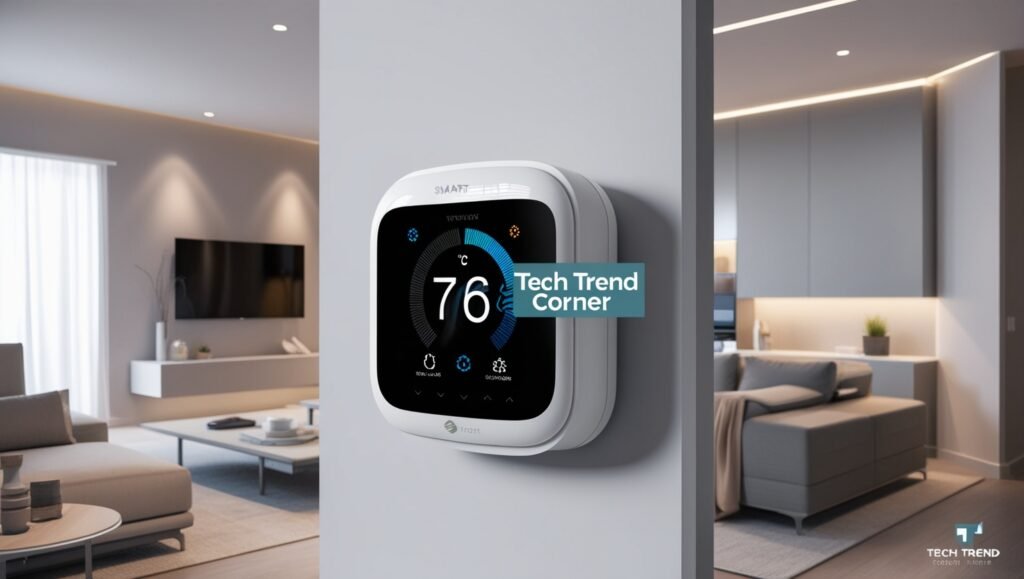
It allows one to control the interiors of the house through a smartphone in various places so that one can be sure energy is not wasted most of the time. Additionally, smart thermostats give clear feedback also recorded on your energy bills so that you can understand some patterns and find better ways to save more.
These will ultimately serve to increase comfort levels and very importantly reduce the energy usage of the entire household.
Smart Lighting Systems
These smart lighting systems have made an incredible change in the ways of lighting up homes, making them energy-efficient and also offering convenience. Most of these high-end systems adopt the modern LED bulbs, which alone use less energy than incandescent bulbs. They commonly have the controls of advanced options like motion sensors, dimming, and programmable schedules.
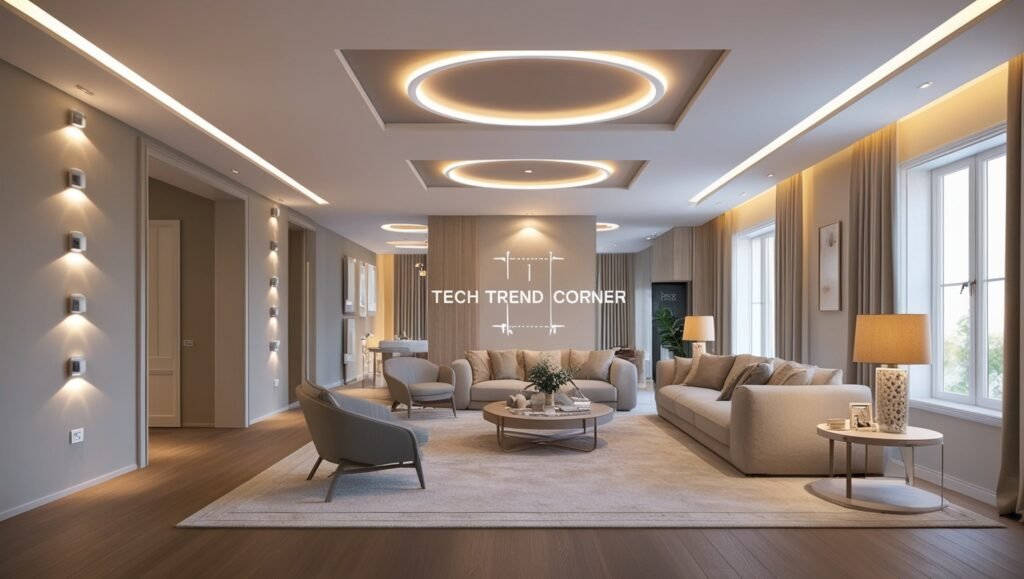
For example, in motion sensors, no one can be inside a room, and the lights turn off by themselves, without the wastage of electricity. The dimming capability leaves the consumer to choose the appropriate brightness he or she wants, thus reducing electricity consumption. Fixed schedules will be programmed to turn on lights at specific hours, only when it is needed according to the daily routines of an individual.
Some smart lighting systems even link into other smart devices around the home, forming an even larger, more cohesive, energy-efficient living ecosystem. It puts the homeowner in touch with being smarter by saving energy, enhancing moods, and using home spaces more effectively.
Smart Plugs and Power Strips
The smart plugs and power strips really act as energy saving tools for any household appliance because now you can control the appliance itself by switching power on or off to devices. This mode is an effective way to make sure the connected appliances are not using electricity when it is not in use. This mode has significantly reduced standby losses, which contributes most to the total energy consumption.
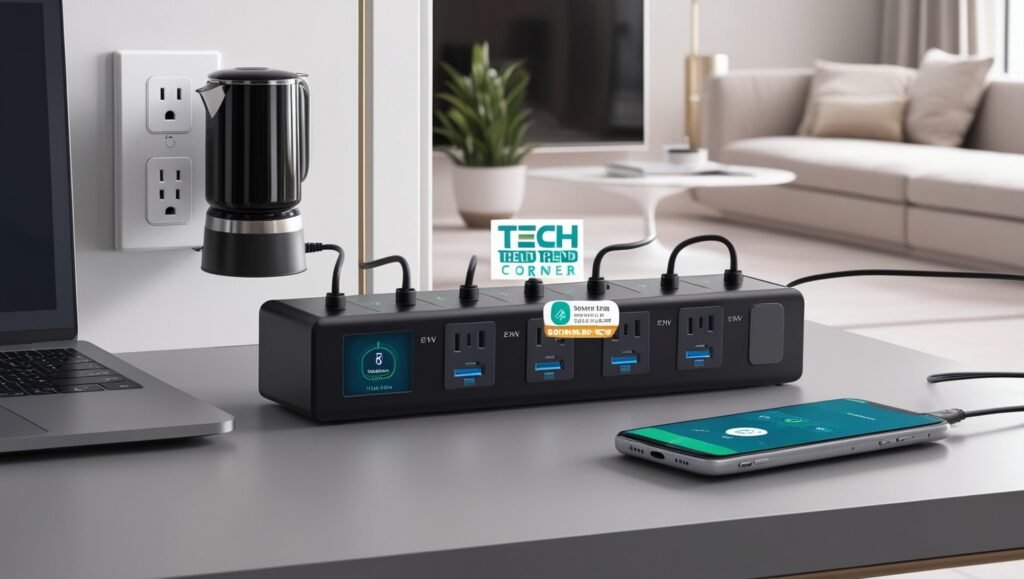
Most smart plugs and power strips provide energy monitoring, in addition to being able to control the energy supply from a distance. This would include real-time energy consumption data for each of the powered devices, making it easier to know which ones are energy-guzzlers—and that very important information is an informed approach to just how you would organize your strategy on consuming energy and possibly saving more.
They are easy to install and very simple in using case scenarios, and can easily be introduced as a great component in every home. So take advantage of these devices among others in your smart home solution, and control the energy consumption for your household.
Smart Energy Monitoring Systems
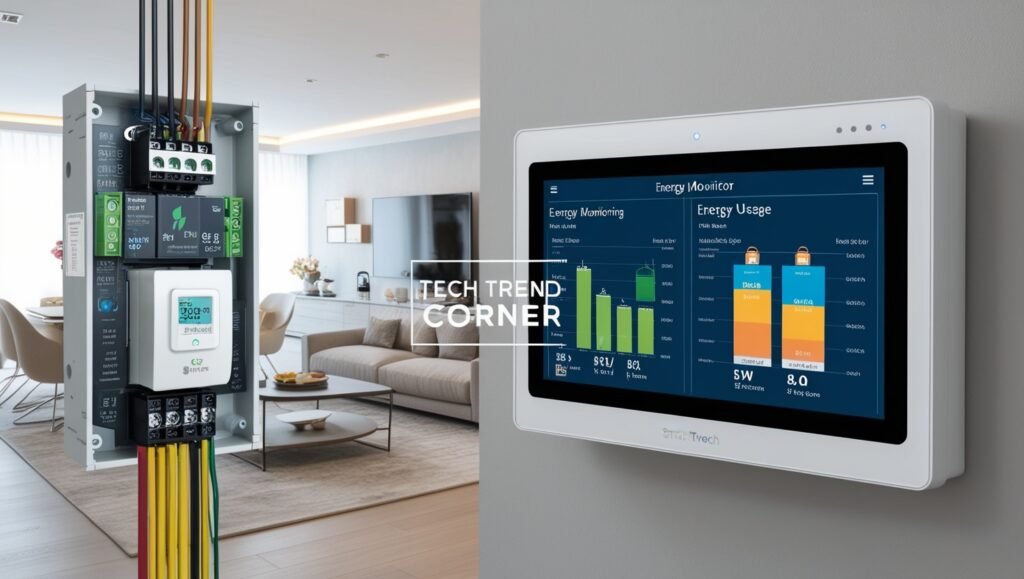
This would be very important for understanding the home energy consumption in a much wider way. These are usually in real-time for the energy use, very specific about how and where energy is consumed, and with that information, homeowners are able to decide what way to manage that energy and find ways where improvements need to be made.
Ordinarily, a smart energy monitor is installed into the main electrical distribution panel at home so that energy usage can be monitored on a single point not only across appliances but also across devices. Some smart energy monitors can measure and provide detailed information of specific circuits or individual appliances that consume energy. This will help identify energy thieves pinpointedly and hasten the deployment of energy saving measures targeted towards them.
The app accompanying the smart energy monitor comes with visualization feeds of energy data, inferring acting upon them easily. Alerts are well put up to give notifications that can prompt you to unusual spikes, thereby making an assessment of the need to take immediate action to prevent wastage.
You may initiate ways of taking smarter energy measures in your home that go a long way in saving the cash and saving the environment, as would have been expected from a smart energy monitor.
Automated Windows and Curtains
These smart glasses and curtains are so wonderful and state-of-the-art. They equip you with intelligent control over light and heat within your home, increasing the building’s energy efficiency. The activities of such systems get adjusted automatically to the maximum use of daylight and to saving indoor temperature-holding, thus reducing the use of lighting and climate control.
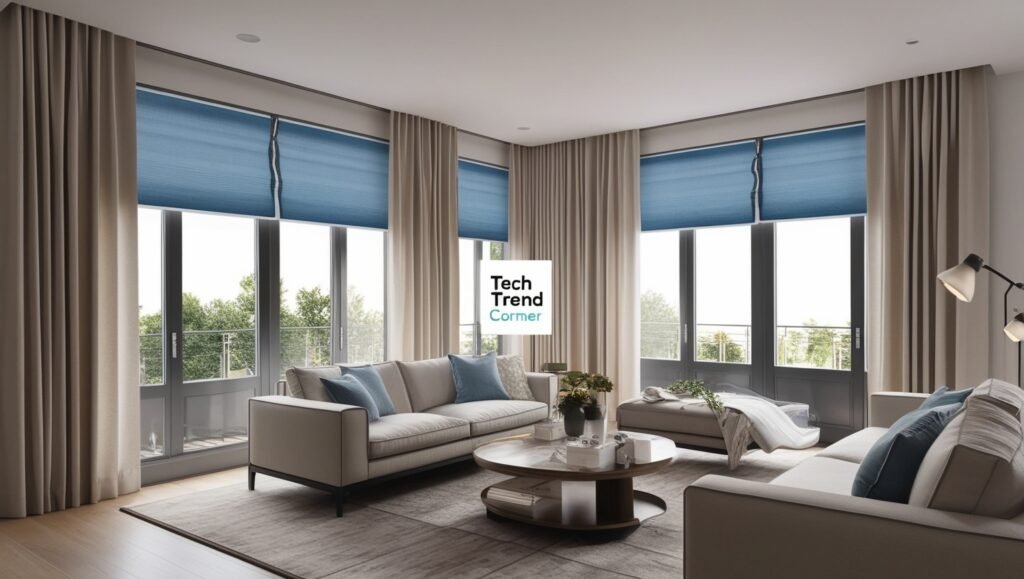
Smart windows—the windows which come up equipped with self-polishable glass, tinting automatically according to the amount of sunlight pouring into the interior, which involves vast heat gain during weekdays, thus highly reducing the air conditioning requirement. Just like smart shades, it can be set to close-open at particular times of the day so that your home can be illuminated by natural light without excessive heat buildup.
Common smart windows and shade systems are integrated with other voice-controlled smart devices, such as smart thermostats and intelligent lighting, thus creating a synchronized energy-efficient environment. For example, smart shades automatically adjust their opening and closing times per the home air temperature, particularly when the thermostat recognizes that there is a lot of light being let in through the windows.
Apart from that, most of them are also remotely controlled and programmable so that they can be used flexibly and easily for lighting and temperature control in the home. Smart windows and shades can potentially reduce energy consumption to a great extent while making your living spaces more comfortable and beautiful.
Benefits of Using These Devices
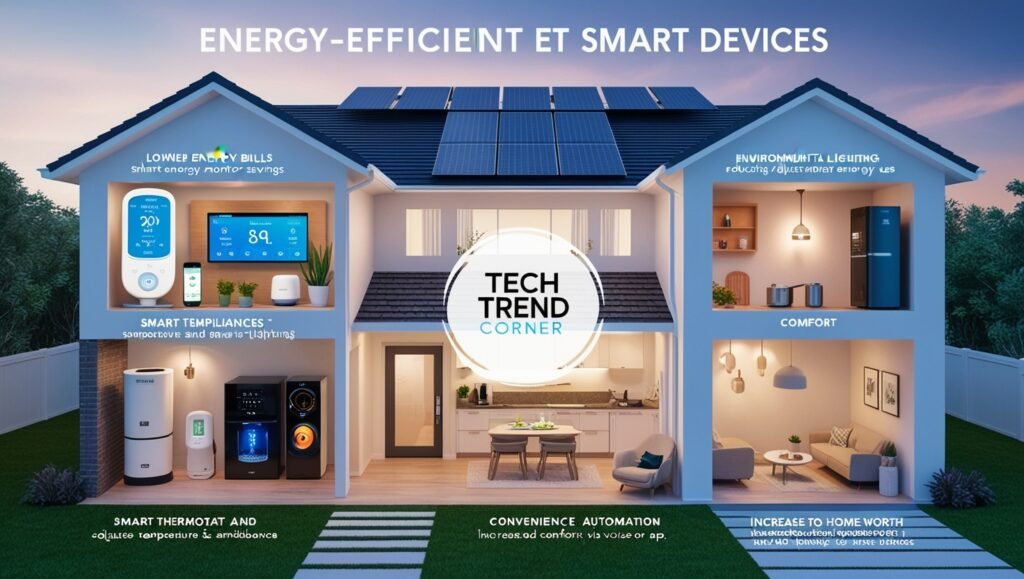
The most impressive aspects of these devices for energy-efficient smart homes are the numerous benefits that extend far beyond a simple conclusion—during the normal routine expense. Here are some important points:
- Lower Energy Bills: Energy-Efficient Smart Home Devices 2025 cause less action on energy consumption and thus cause the utility bills to come down month after month. Features such as automation and real-time monitoring account for the exact period when energy is required or even when it’s not; therefore, the aggregate saves cost value after some time.
- Environmental Conservation: Cutting down power usage also helps in reducing carbon footprints. Energy-Efficient Smart Home Devices 2025 have gone a step forward in helping mitigate climate change and promoting sustainability of the environment through energy-efficiency practices.
- Convenience and Automation: These automation tools have made the routines of daily living much simpler, even enabling one to control one’s home from anywhere in the world. Since one can even adjust settings from anywhere, it makes everything a lot more relaxed and not too nervous.
- Sustainable and Responsible: Adoption of energy-efficient technology is synonymous with an act of commitment to a sustainable and responsible kind of living. It is a step towards ensuring that future generations experience a better world.
Such advantages make Energy-Efficient Smart Home Devices 2025 save energy at the same time, build up an environment that advocates comfort and helps the whole world in financial independence and environmental responsibility.
How to Integrate Smart Devices for Optimal Energy Efficiency
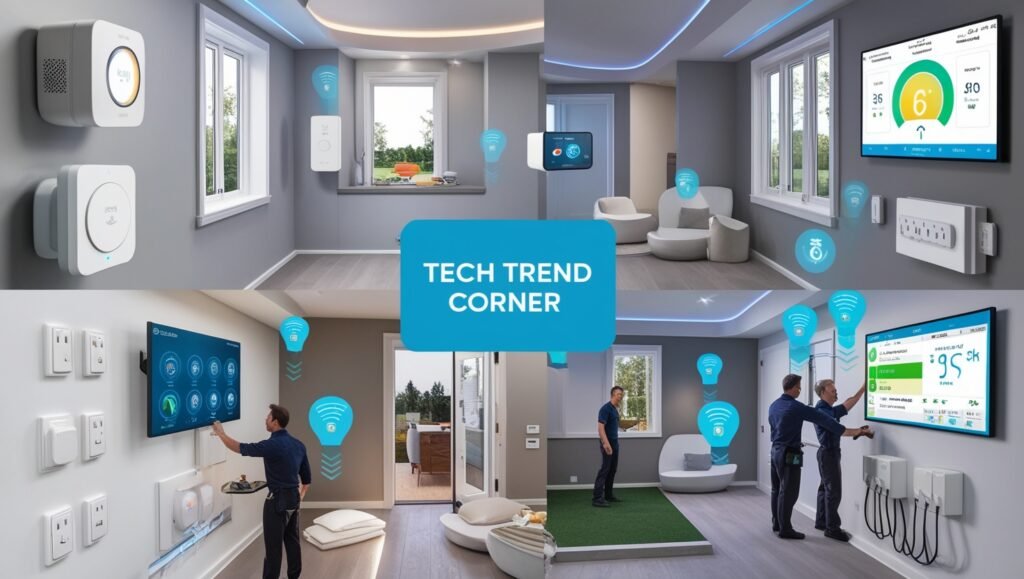
However, bringing the home into an integrated, well-oiled machine is key to fully exploiting the energy benefits these devices have to offer. Here are some ways you could bring them together for better integration and performance:
- Central Hub or Platform: Use one single platform or hub for your smart home, where everything can be communicated. The Amazon Alexa, Google Home, or Apple HomeKit platforms allow this.
- Built-in Compatibility: Compatibility ensures that all of the Energy-Efficient Smart Home Devices 2025 are part of the network, sharing a platform for swift communication and synchronized operation, thereby improving energy use.
- Regular Software Updates: Update your devices firmware regularly in order to enjoy new features, improved energy-saving capabilities and improved security enhancements. New updates are released often within manufacturers to boost their performance and efficiency.
- Energy Monitoring and Adjustments: Smart use of electricity monitoring is the continuous usage of energy consumption measurement devices. A good analysis of the data will reveal patterns in energy use and adjustments should be made as appropriate for any settings on appliances and/or changes in user behavior to provide maximum energy savings.
- Professional Installation and Setup: Sometimes, expert installation may be warranted in the case of complicated systems, such as smart HVAC or total-home integrated lighting. Proper installation, then, means that the devices will be carrying out their functions properly and efficiently, with maximum energy savings.
- User Training and Familiarization: Familiarity with the many smart devices’ features and functionalities should be the order of the day. In time, and by using the appliances, one becomes more familiarized with them and understands well how to use and customize for that matter to gain better efficiency in its usage and to ensure that the most is being done with them.
- Strong Security Measures: The first step in securing your smart home system from unauthorized entry is strong security. Strong passwords, an active two-factor authentication setup, regular updates on security configurations, and other security measures will help you protect your devices and personal data.
With these integration strategies, you will create a congruent, efficient smart home capable of active energy savings while enhancing your experience of living.
Progressive Innovations in Smart Home Energy Efficiency

Energy-Efficient Smart Home Devices 2025 continue to advance as we look to the future, becoming even more sophisticated with inventive approaches to energy conservation. According to the U.S. Department of Energy, optimizing energy usage is crucial for mitigating climate change and reducing rising energy costs. Here are some few trends-in-waiting that will shape the smart home energy management scene:
- Energy Savings through AI: Energy efficiency is improved significantly with Artificial Intelligence. AI-sponsored systems seem to collect a lot of information regarding the conditions of usage of energy to minimize wastage while maximizing savings with their predictive profiles of energy consumption and operation of appliances through intelligent adjustments in real-time.
- Integrated Renewable Energy Reinforcement: The increasingly seamless integration of renewable energy sources—generally including solar panels and wind turbines—with smart home systems is enhanced with smart inverters and energy storage options that enable smart homeowners to manage and use energy better than depending on a conventional power company. Learn more about integrating renewables with smart homes at Renewable Energy World.
- Improved Device Interoperability: Better device interoperability between devices from different manufacturers is obligatory as the smart home ecosystem expands. Standardized communication protocols combined with enhanced compatibility features will ensure that devices even from different manufacturers can work perfectly in synchrony to form an efficient and cohesive energy management system. Refer to IEEE’s Smart Home Standards for more information on the protocols
- Advanced Energy Storage Solutions: The storage of energy is going through advanced innovations, such as more effective batteries and energy management systems, marking a revolution in storage and utilization for smart homes. It increases the self-consumption of electricity and makes the grid dependent on it, thus improving a house’s resiliency.
- Better Personalization of Energy Optimization: The automation of future homes will be highly personalized and will generate energy management activities based on the users’ unique needs and habits. Such systems will know the needs of every household to facilitate energy savings in a more appropriate way.
- Increasing Communication with Smart Grids: More dynamic and efficient energy distribution will come via the connection of smart houses with smart grids. This synergy also brings demand-response level adjustments to energy usage in terms of grid conditions, contributing to more overall grid stability and efficiency.
- Advanced Functions through Smart Home Appliances: Appliances’ technology will keep on evolving and, therefore, have more complex capabilities emphasizing energy efficiency. Predictive maintenance has enhanced connectivity as well as smart algorithms for operation, thereby rendering smart appliances much more efficient and responsive to the need for energy savings.
Conclusion
All these trends from the future reflect the futuristic trend of smart homes. The promise is that smart homes will not only improve energy efficiency but also take the next leap of sustainability. Not only do they assist to lead a greener lifestyle, but they also work wonders in significantly reducing energy costs. Energy-Efficient Smart Home Devices 2025 such as smart thermostats, smart lighting systems, smart plugs and power strips, smart appliances, smart energy meters, smart windows and shades can all be tidily integrated into your home to ensure that it is super cozy and energy-efficient.
Indeed these devices boost efficiency, but they also go ahead to build a way of life storage that is more long-term and improves the quality of life. In fact, energy efficiency becomes another effortless aspect in the full-fledged networking of these devices within a smart home ecosystem. Trends that are expected to adjust in the near future will also keep patching one’s home so that it will continuously enhance energy efficiency, even in light of new developments.
Read more about Smart Home Technology for a Modern Lifestyle.
Frequently Asked Questions
-
What would be the major benefits of applying Energy-Efficient Smart Home Devices 2025 for energy savings and efficiency?
Energy-Efficient Smart Home Devices 2025 cut energy bills and reduce carbon footprints while improving comfort, convenience through automation, increasing property value, offering data-driven insights for improved energy management, and supporting greener living.
-
What are the things that I have to look into before buying an Energy-Efficient Smart Home Device 2025 for energy efficiency?
Things that should be considered are automation and control options; compatibility with existing home systems; real-time monitoring; cost; historical evidence about actual energy savings; and capacity for future expandability.
-
What would be the best home energy-efficient smart devices in the year 2025?
Some top devices are Energy-Efficient Smart Home Devices 2025 like smart thermostats, smart lighting systems, smart plugs and power strips, smart appliances, smart energy monitoring systems, smart HVAC systems, and automated windows and curtains to assist very well in energy management.
-
How do smart thermostats save energy?
Smart thermostats learn your routines, derive your heating and cooling according to occupancy and external temperatures, enable smartphone remote control, and feedback when consuming energy—the total combination aims to reduce energy wastage and utility bills.
-
How will I make many Energy-Efficient Smart Home Devices 2025 work together to maximize energy saving?
Connect every device in one of those hubs/platforms such as Amazon Alexa, Google Home, and Apple HomeKit; check whether your devices will work together; set up the automation routines; keep software updated; monitor power usage; and hire an expert for seamless installation.
-
What are the future smart home technologies to steer energy efficiency?
Progressive innovations: energy management in equipment by AI, integrating renewable sources, improved interoperability of devices, energy storing tablets, personalization in energy optimization, communicable smart grids, or sustainability certifying instituting.
-
Is it worth investing in Energy-Efficient Smart Home Devices 2025 in the long run?
Yes, while initial and various costs exist, devices considered smart will conserve because they take up less energy, help reduce utility consumption, improve house values, and save on the long-time cost of sustainability, making them genuinely cost-effective over time.
Read more about Potential Dangers of Smart Voice-Controlled Homes.

